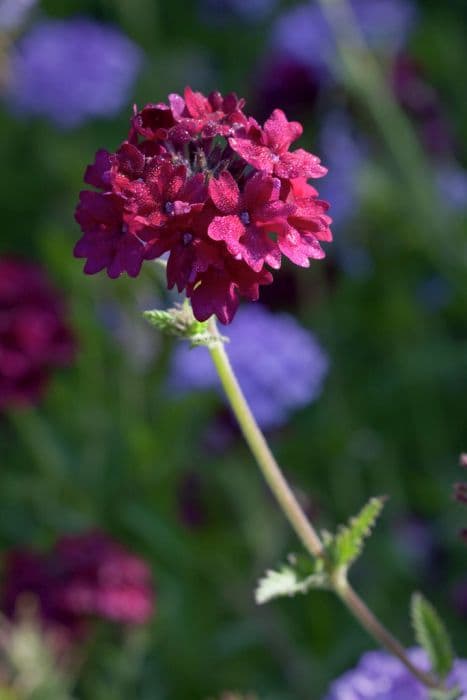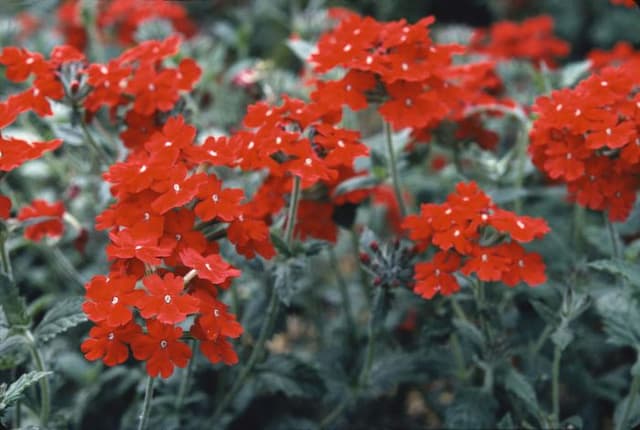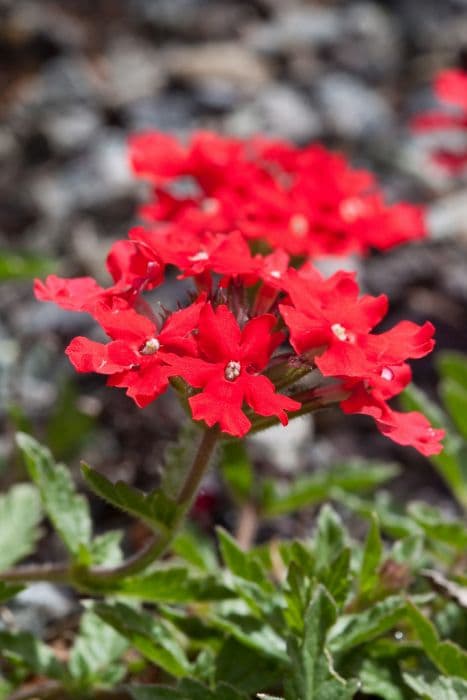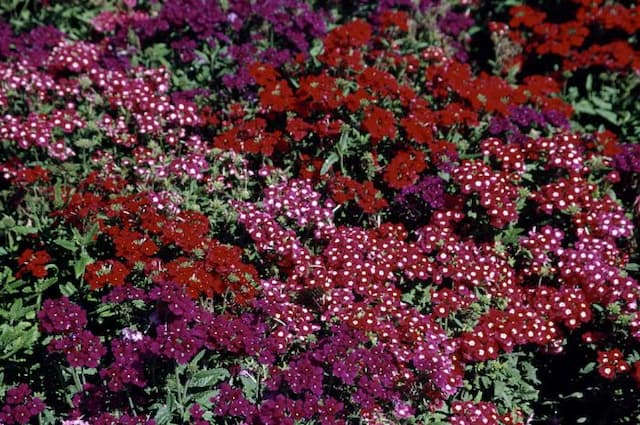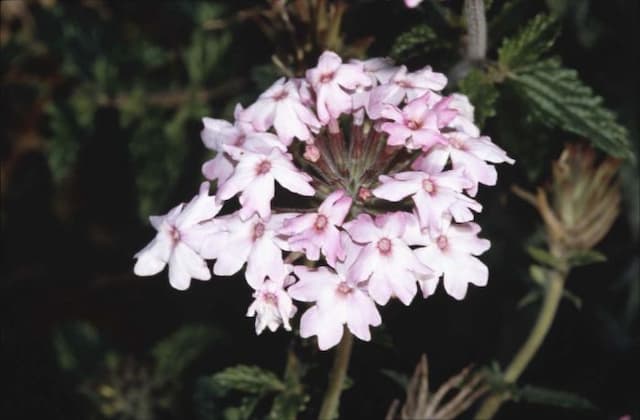Verbena Glandularia 'Moon River'

ABOUT
Glandularia 'Moon River', commonly known as Moon River verbena, is a perennial often admired for its showy floral display and attractive foliage. The plant is characterized by masses of small, trumpet-shaped flowers which come in a vivid palette of colors often ranging from purple to blue tones. The blossoms are uniquely arrayed in tight clusters that create a cushion-like appearance, adding to the plant's ornamental value. The foliage of Moon River verbena consists of narrow, oblong leaves which are coarsely toothed. The leaves are typically a deep green color and have a somewhat wrinkled texture, adding a lush, verdant backdrop to the vibrant flowers. The stems of the plant are slender and may have a trailing or spreading habit, which makes it particularly appealing for use in hanging baskets and as a ground cover where the foliage and blooms can gracefully cascade and spread. Together, the harmonious combination of the intense floral clusters and the dense, leafy growth gives the Moon River verbena a full and robust appearance. Its growth habit and striking blossoms make it a beloved choice for gardeners seeking to add long-lasting color to their landscape.
About this plant
 Names
NamesFamily
Verbenaceae.
Synonyms
Garden Verbena, Clustertop Verbena, Rose Vervain, Moon River Verbena.
Common names
Glandularia 'Moon River'
 Toxicity
ToxicityTo humans
The Glandularia 'Moon River', more commonly known as verbena, is not known to be toxic to humans. No significant toxic effects have been reported from ingesting this plant. However, as with many plants, sensitive individuals may experience mild gastrointestinal upset if they consume parts of the verbena. It is always recommended to avoid eating ornamental plants due to potential individual reactions and the possibility of pesticide or herbicide contamination.
To pets
For pets, the verbena, which is the common name for Glandularia 'Moon River', is also not recognized as a toxic plant. Pets that ingest verbena might experience mild digestive discomfort, but there's no well-documented evidence of serious toxicity or poisoning from this plant in pets. However, it's still prudent to monitor pets and prevent them from excessive chewing or ingesting of non-food plants, which can lead to stomach upset or other health issues related to ingestion of foreign matter.
 Characteristics
CharacteristicsLife cycle
Perennials
Foliage type
Deciduous
Color of leaves
Green
Flower color
Purple
Height
1 foot (0.3 meters)
Spread
2 feet (0.6 meters)
Plant type
Herb
Hardiness zones
7
Native area
Americas
Benefits
 General Benefits
General Benefits- Attracts pollinators: Glandularia 'Moon River', commonly known as Verbena, is known to attract butterflies and bees, which are essential for the pollination of many plants.
- Drought tolerance: Verbena is tolerant to dry conditions, making it a suitable plant for regions with water scarcity or for gardeners seeking low-water-use landscapes.
- Easy to grow: This plant is known for being easy to care for, requiring minimal maintenance, which makes it ideal for novice gardeners.
- Long blooming season: Verbena has a lengthy blooming period, often from spring to fall, providing extended color in the garden.
- Versatility: It can be used in various garden settings, including borders, containers, and as ground cover, offering flexibility in garden design.
- Deer resistance: Verbena is typically resistant to deer, saving gardens from potential damage in areas where deer are a common problem.
 Medical Properties
Medical PropertiesThis plant is not used for medical purposes.
 Air-purifying Qualities
Air-purifying QualitiesThis plant is not specifically known for air purifying qualities.
 Other Uses
Other Uses- Glandularia 'Moon River', commonly known as verbena, can be used in eco-friendly dyeing processes due to its pigments that may bond well with natural fibers.
- Verbena can serve as an educational tool in botany and horticulture classes to study plant growth patterns, hybridization, and garden design.
- Garden designers often use verbena in xeriscaping, as it requires minimal watering and is well-suited for drought-tolerant landscapes.
- Its colorful flowers can be used as a natural indicator for the pH of soil; changes in soil chemistry may alter the color of verbena blooms.
- Verbena can be integrated into sensory gardens for its texture and fragrance, providing an interactive experience for visitors, particularly beneficial for individuals with sensory processing disorders.
- Desiccated verbena flowers can be included in potpourri mixtures to add fragrance and color to a room.
- The flowers of verbena can be pressed and used in botanical art or to create naturally decorative bookmarks, cards, or other paper goods.
- As a companion plant, verbena can attract beneficial insects like pollinators or predatory insects that help maintain the health of a garden ecosystem.
- Verbena's vibrant flowers can be used in edible landscaping, combining ornamental beauty with edible elements, though caution should be exercised as not all parts may be edible.
- The plant can be used for temporary ground cover in event designs, providing a splash of color for outdoor occasions while covering unsightly patches of soil.
Interesting Facts
 Feng Shui
Feng ShuiThe plant Glandularia 'Moon River,' commonly known as verbena, is not typically used in Feng Shui practice.
 Zodiac Sign Compitability
Zodiac Sign CompitabilityThe verbena is not used in astrology practice.
 Plant Symbolism
Plant Symbolism- Transformation: The Glandularia 'Moon River,' commonly known as verbena, often represents change and metamorphosis. Its growth from seed to flower symbolizes the journey and the transformative power of nature.
- Healing: Verbena has a history of being used for medicinal purposes, thus it carries the symbolic meaning of healing and recovery.
- Happiness: With its bright and clustered blooms, verbena embodies happiness and brings joy to gardens and landscapes, symbolizing a cheerful spirit.
- Attracting Good Fortune: Verbena is sometimes thought to bring good luck and is used in various cultures to attract positive energies.
- Harmony and Peace: The calming presence of verbena blossoms is often associated with creating a peaceful environment and nurturing harmonious relationships.
 Water
WaterVerbena 'Moon River' should be watered regularly, ensuring that the soil is kept consistently moist but not waterlogged. Typically, watering should be done when the top inch of soil feels dry to the touch. The amount of water needed will vary with the size of the plant and the environmental conditions, but as a general guideline, watering with approximately 1 gallon every week or every other week during the growing season should suffice. During hot spells, more frequent watering may be necessary. Always water at the base of the plant to avoid wetting the foliage, which can lead to fungal diseases.
 Light
LightVerbena 'Moon River' thrives best in full sun conditions, meaning it needs at least 6 hours of direct sunlight each day. The ideal spot for planting or placing this verbena would be in an area where it receives unobstructed sunlight for most of the day. Partial shade is tolerable, especially in hotter climates, but full sun is preferable for optimal growth and bloom.
 Temperature
TemperatureVerbena 'Moon River' prefers moderate to warm temperatures and can thrive in a temperature range between 60 and 80 degrees Fahrenheit. Although it can tolerate temperatures down to about 40 degrees Fahrenheit, it should be protected from frost. The ideal conditions for growing 'Moon River' are mild and not exposed to extreme heat above 90 degrees Fahrenheit or freezing conditions.
 Pruning
PruningPruning Verbena 'Moon River' is essential for encouraging bushier growth and more blooms. Deadhead spent flowers regularly to promote continuous flowering. Perform a more substantial pruning in late winter or early spring, cutting back to about one-third of its size to rejuvenate the plant and prevent it from becoming leggy. The best time for pruning is after the last frost when new growth begins to appear.
 Cleaning
CleaningAs needed
 Soil
SoilFor Glandularia 'Moon River', commonly known as Verbena, a well-draining soil mix with added perlite or sand is ideal to ensure good drainage. Incorporate organic materials like compost or peat moss to retain some moisture. Ensure a slightly acidic to neutral pH ranging from 6.0 to 7.0 for optimal growth.
 Repotting
RepottingVerbena, or Glandularia 'Moon River', typically does not require frequent repotting and can usually be repotted every 2-3 years or when the plant outgrows its current container.
 Humidity & Misting
Humidity & MistingVerbena (Glandularia 'Moon River') prefers moderate humidity levels but is quite adaptable and can tolerate lower humidity environments typically found indoors.
 Suitable locations
Suitable locationsIndoor
Place Verbena near a sunny window; ensure moderate humidity.
Outdoor
Choose sunny location; protect Verbena from intense afternoon heat.
Hardiness zone
6-9 USDA
 Life cycle
Life cycleThe Glandularia 'Moon River', commonly known as Verbena, begins its life cycle when seeds are sown in well-draining soil under appropriate light and temperature conditions. After germination, the seedlings grow and develop into young plants with characteristic toothed leaves and a spreading habit. As the plant matures, it enters the vegetative stage, where it invests energy into leaf and stem growth, establishing a strong root system. Following vegetative growth, Verbena enters the flowering stage, producing clusters of small, vibrant flowers that attract pollinators for reproduction. After successful pollination, the flowers develop into fruit that contain seeds, which, when mature, are released into the environment to start a new generation. Lastly, in areas where it is not perennial, the plant will reach the end of its life cycle and die after seed dispersal, completing its annual or biennial cycle depending on the climate.
 Propogation
PropogationPropogation time
Spring to early summer
The most popular method of propagating Glandularia 'Moon River', commonly known as verbena, involves taking stem cuttings. The best time for this is late spring to early summer when the plant is actively growing. Choose a healthy, non-flowering stem and cut a piece about 4 to 6 inches (10 to 15 centimeters) long, just below a leaf node. Remove the leaves from the lower half of the cutting and dip the cut end in rooting hormone to encourage root development. Then, plant the cutting in a pot filled with moistened potting mix, ensuring at least one or two nodes are buried where the removed leaves were, as this is where roots will form. Cover the pot with a plastic bag to maintain humidity and place it in a warm, brightly lit area out of direct sunlight until roots have developed, which typically takes a few weeks. Once rooted, the new verbena plants can be transplanted to their final location.
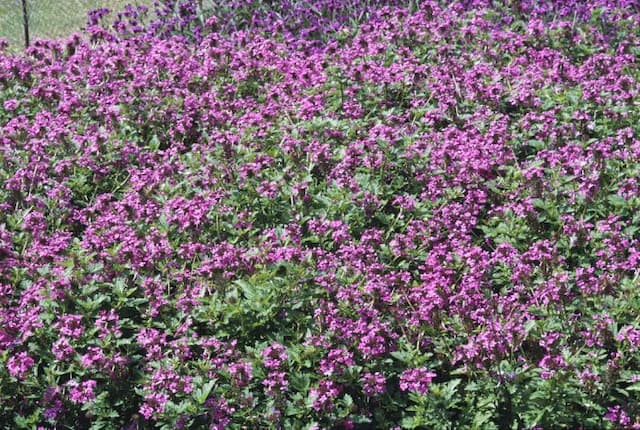
![Vervain [Endurascape Pink Bicolor]](/_next/image?url=https%3A%2F%2Fplants-admin.emdemapps.com%2Fimages%2Fplants%2F%2Fimages%2F604b594e749b0.png&w=640&q=75)
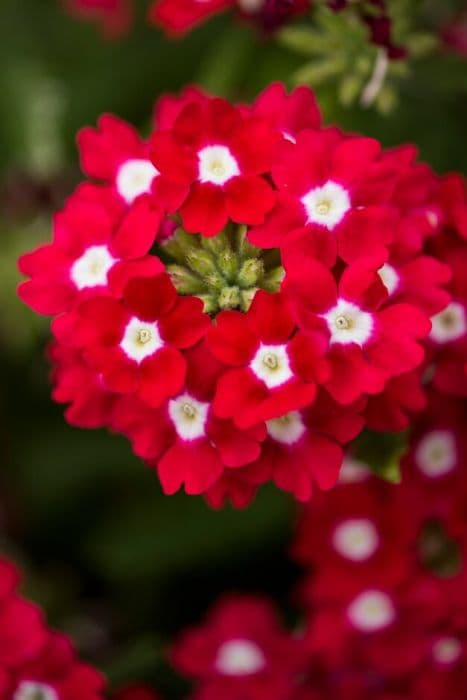
![Vervain [Seabrook's Lavender]](/_next/image?url=https%3A%2F%2Fplants-admin.emdemapps.com%2Fimages%2Fplants%2F%2Fimages%2F604b650ea9729.png&w=640&q=75)

